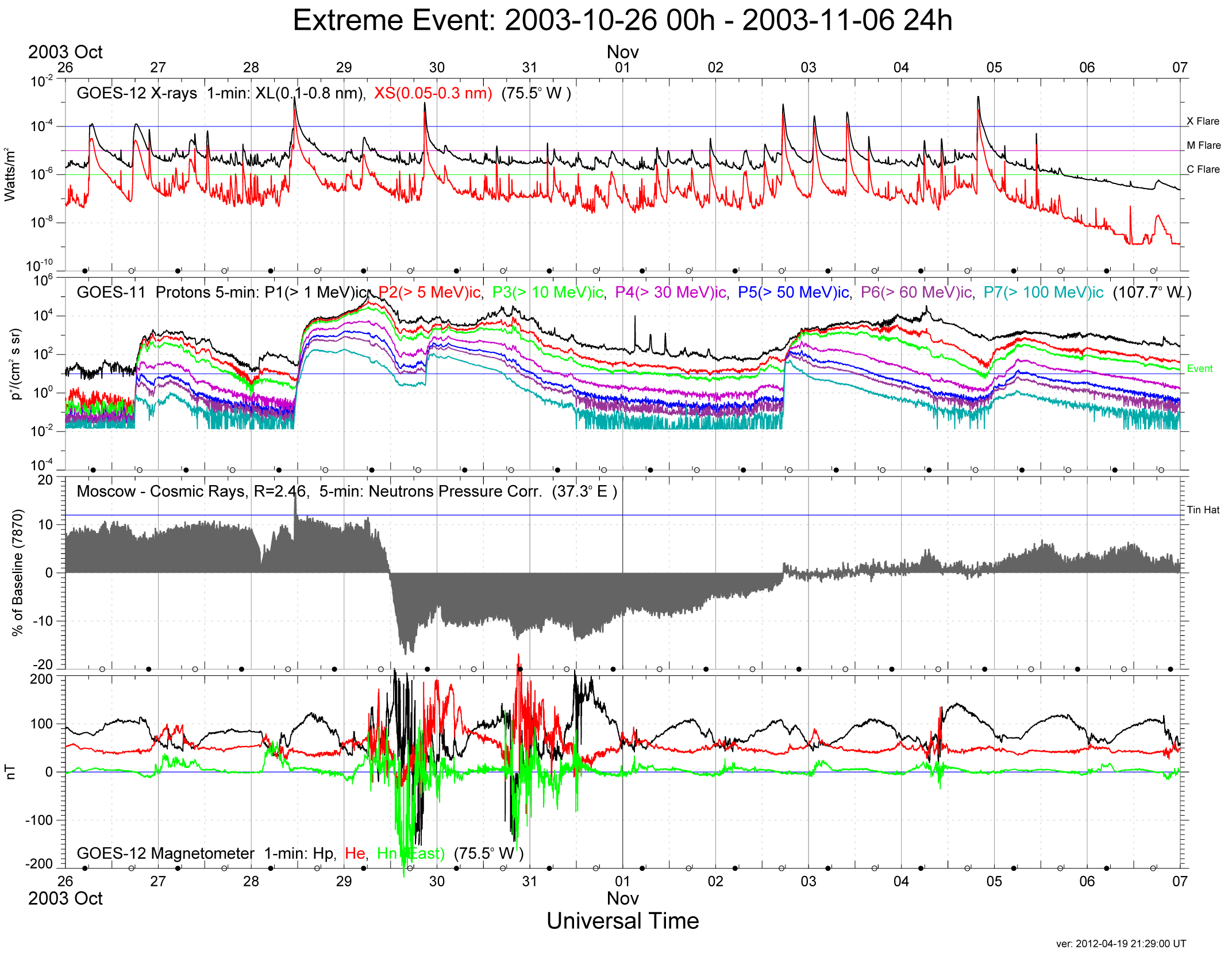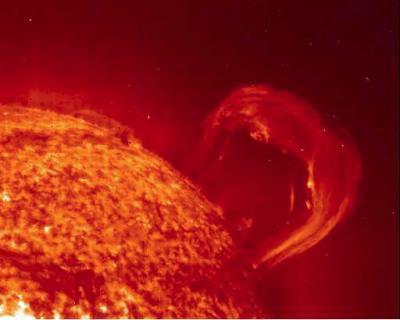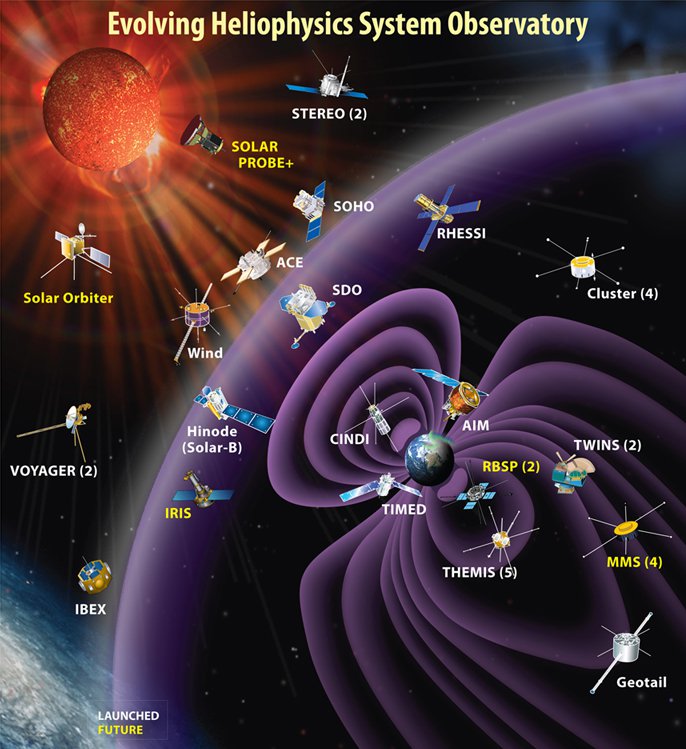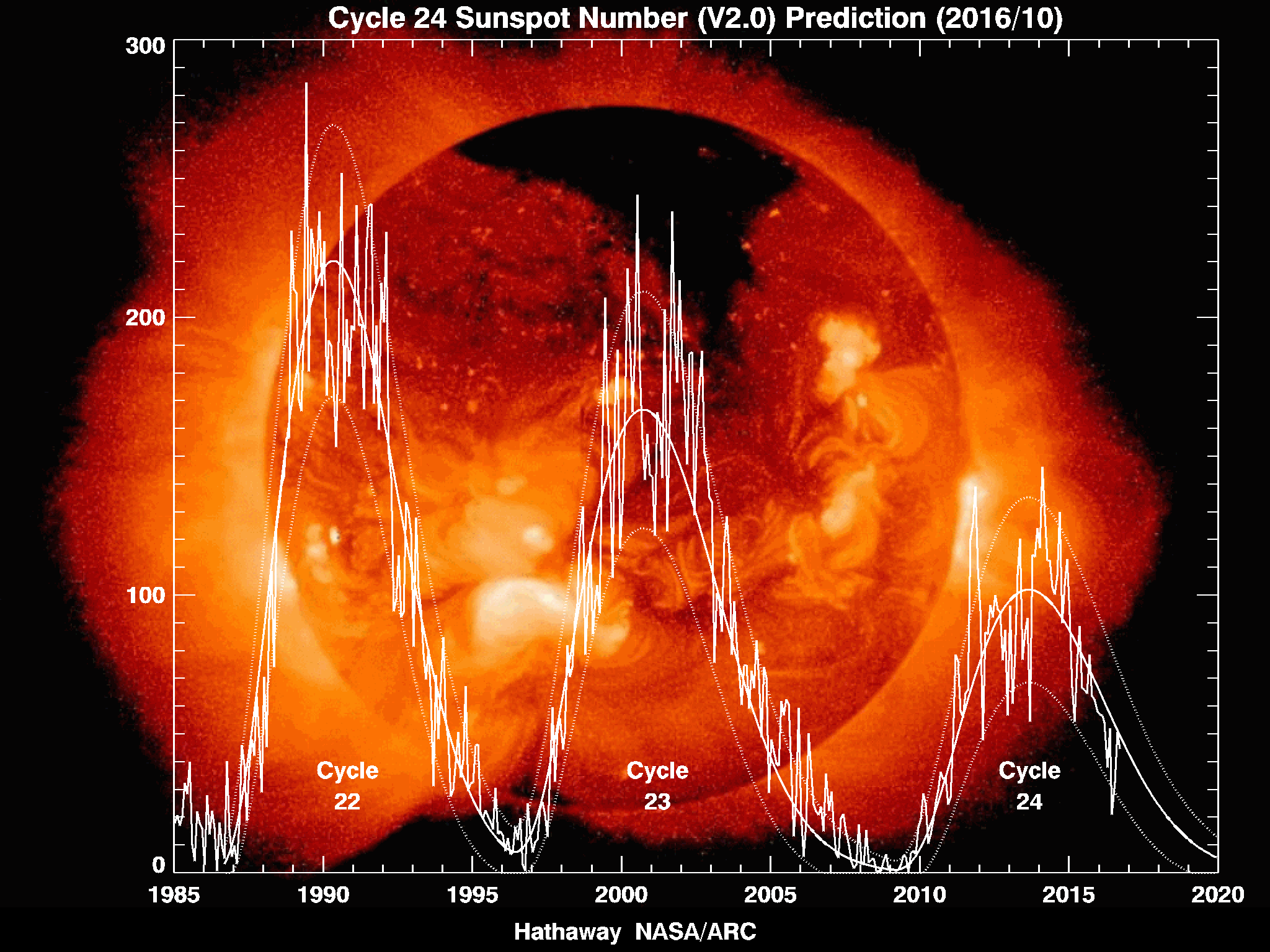|
Ground Level Enhancement
A Ground Level Enhancement or Ground Level Event (GLE), is a special subset of solar particle event where charged particles from the Sun have sufficient energy to generate effects which can be measured at the Earth's surface. These particles (mostly protons) are accelerated to high energies either within the solar atmosphere or in interplanetary space, with some debate as to the predominant acceleration method. While solar particle events typically involve solar energetic particles at 10–100 MeV, GLEs involve particles with significantly higher energies of >500 MeV. Description Charged particles from the Sun generally do not possess the energy required to penetrate the Earth's magnetic field or Upper atmosphere. However, a small number of solar events produce charged particles which are able to penetrate these layers, causing an air shower. This particle shower reaches ground level, where effects are measured, leading to the name "Ground Level Enhancement". These effects are usu ... [...More Info...] [...Related Items...] OR: [Wikipedia] [Google] [Baidu] |
Solar Particle Event
In solar physics, a solar particle event (SPE), also known as a solar energetic particle (SEP) event or solar radiation storm, is a solar phenomenon which occurs when particles emitted by the Sun, mostly protons, become accelerated either in the Sun's atmosphere during a solar flare or in interplanetary space by a coronal mass ejection shock. Other nuclei such as helium and HZE ions may also be accelerated during the event. These particles can penetrate the Earth's magnetic field and cause partial ionization of the ionosphere. Energetic protons are a significant radiation hazard to spacecraft and astronauts. Description SPEs occur when charged particles in the Sun's atmosphere are accelerated to extremely high velocities. These charged particles, referred to as solar energetic particles, can escape into interplanetary space where they follow the interplanetary magnetic field. When solar energetic particles interact with the Earth's magnetosphere, they are guided by the Earth's ... [...More Info...] [...Related Items...] OR: [Wikipedia] [Google] [Baidu] |
Solar Flares
A solar flare is an intense localized eruption of electromagnetic radiation in the Sun's atmosphere. Flares occur in active regions and are often, but not always, accompanied by coronal mass ejections, solar particle events, and other solar phenomena. The occurrence of solar flares varies with the 11-year solar cycle. Solar flares are thought to occur when stored magnetic energy in the Sun's atmosphere accelerates charged particles in the surrounding plasma. This results in the emission of electromagnetic radiation across the electromagnetic spectrum. High-energy electromagnetic radiation from solar flares is absorbed by the daylight side of Earth's upper atmosphere, in particular the ionosphere, and does not reach the surface. This absorption can temporarily increase the ionization of the ionosphere which may interfere with short-wave radio communication. The prediction of solar flares is an active area of research. Flares also occur on other stars, where the term ''stellar f ... [...More Info...] [...Related Items...] OR: [Wikipedia] [Google] [Baidu] |
Solar Particle Event
In solar physics, a solar particle event (SPE), also known as a solar energetic particle (SEP) event or solar radiation storm, is a solar phenomenon which occurs when particles emitted by the Sun, mostly protons, become accelerated either in the Sun's atmosphere during a solar flare or in interplanetary space by a coronal mass ejection shock. Other nuclei such as helium and HZE ions may also be accelerated during the event. These particles can penetrate the Earth's magnetic field and cause partial ionization of the ionosphere. Energetic protons are a significant radiation hazard to spacecraft and astronauts. Description SPEs occur when charged particles in the Sun's atmosphere are accelerated to extremely high velocities. These charged particles, referred to as solar energetic particles, can escape into interplanetary space where they follow the interplanetary magnetic field. When solar energetic particles interact with the Earth's magnetosphere, they are guided by the Earth's ... [...More Info...] [...Related Items...] OR: [Wikipedia] [Google] [Baidu] |
Space Weather
Space weather is a branch of space physics and aeronomy, or heliophysics, concerned with the time varying conditions within the Solar System, including the solar wind, emphasizing the space surrounding the Earth, including conditions in the magnetosphere, ionosphere, thermosphere, and exosphere. Space weather is distinct from, but conceptually related to, the terrestrial weather of the atmosphere of Earth (troposphere and stratosphere). The term "space weather" was first used in the 1950s and came into common usage in the 1990s. Later, it was generalized to a " space climate" research discipline, which focuses on general behaviors of longer and larger-scale variabilities and effects. History For many centuries, the effects of space weather were noticed, but not understood. Displays of auroral light have long been observed at high latitudes. Genesis In 1724, George Graham reported that the needle of a magnetic compass was regularly deflected from magnetic north over the c ... [...More Info...] [...Related Items...] OR: [Wikipedia] [Google] [Baidu] |
Solar Energetic Particles
Solar energetic particles (SEP), formerly known as solar cosmic rays, are high-energy, charged particles originating in the solar atmosphere and solar wind. They consist of protons, electrons and heavy ions with energies ranging from a few tens of keV to many GeV. The exact processes involved in transferring energy to SEPs is a subject of ongoing study. SEPs are relevant to the field of space weather, as they are responsible for SEP events and ground level enhancements. History SEPs were first detected in February and March 1942 by Scott Forbush indirectly as ground level enhancements. Solar particle events SEPs are accelerated during solar particle events. These can originate either from a solar flare site or by shock waves associated with coronal mass ejections (CMEs). However, only about 1% of CMEs produce strong SEP events. Two main mechanisms of acceleration are possible: diffusive shock acceleration (DSA, an example of second-order Fermi acceleration) or the shock-drif ... [...More Info...] [...Related Items...] OR: [Wikipedia] [Google] [Baidu] |
List Of Solar Storms
Solar storms of different types are caused by disturbances on the Sun, most often from coronal mass ejections (CMEs) and solar flares from active regions, or, less often, from coronal holes. Minor to active solar storms (i.e. storming restricted to higher latitudes) may occur under elevated background solar wind conditions when the interplanetary magnetic field (IMF) orientation is southward, toward the Earth (which also leads to much stronger storming conditions from CME-related sources). Background Active stars produce disturbances in space weather and, if strong enough, in their own space climate. Science studies such phenomena with the field of heliophysics, which is an interdisciplinary combination of solar physics and planetary science. In the Solar System, the Sun can produce intense Geomagnetic storm, geomagnetic and Solar particle event, energetic particle storms capable of causing severe damage to technology. It can result in large scale power outages, disruption or Com ... [...More Info...] [...Related Items...] OR: [Wikipedia] [Google] [Baidu] |
Heliophysics
Heliophysics (from the prefix " helio", from Attic Greek ''hḗlios'', meaning Sun, and the noun "physics": the science of matter and energy and their interactions) is the physics of the Sun and its connection with the Solar System. NASA defines heliophysics as "(1) the comprehensive new term for the science of the Sun - Solar System Connection, (2) the exploration, discovery, and understanding of Earth's space environment, and (3) the system science that unites all of the linked phenomena in the region of the cosmos influenced by a star like our Sun." Heliophysics concentrates on the Sun's effects on Earth and other bodies within the Solar System, as well as the changing conditions in space. It is primarily concerned with the magnetosphere, ionosphere, thermosphere, mesosphere, and upper atmosphere of the Earth and other planets. Heliophysics combines the science of the Sun, corona, heliosphere and geospace, and encompasses a wide variety of astronomical phenomena, including ... [...More Info...] [...Related Items...] OR: [Wikipedia] [Google] [Baidu] |
Solar Maximum
Solar maximum is the regular period of greatest solar activity during the Sun's 11-year solar cycle. During solar maximum, large numbers of sunspots appear, and the solar irradiance output grows by about 0.07%. On average, the solar cycle takes about 11 years to go from one solar maximum to the next, with duration observed varying from 9 to 14 years. Large solar storms often occur during solar maximum. For example, the Carrington Event, which took place a few months before the solar maximum of solar cycle 10, was the most intense geomagnetic storm in recorded history and widely considered to have been caused by an equally large solar storm. Predictions Predictions of a future maximum's timing and strength are very difficult; predictions vary widely. There was a solar maximum in 2000. In 2006, NASA initially expected a solar maximum in 2010 or 2011, and thought that it could be the strongest since 1958. [...More Info...] [...Related Items...] OR: [Wikipedia] [Google] [Baidu] |
Geosynchronous Orbit
A geosynchronous orbit (sometimes abbreviated GSO) is an Earth-centered orbit with an orbital period that matches Earth's rotation on its axis, 23 hours, 56 minutes, and 4 seconds (one sidereal day). The synchronization of rotation and orbital period means that, for an observer on Earth's surface, an object in geosynchronous orbit returns to exactly the same position in the sky after a period of one sidereal day. Over the course of a day, the object's position in the sky may remain still or trace out a path, typically in a figure-8 form, whose precise characteristics depend on the orbit's inclination and eccentricity. A circular geosynchronous orbit has a constant altitude of . A special case of geosynchronous orbit is the geostationary orbit, which is a circular geosynchronous orbit in Earth's equatorial plane with both inclination and eccentricity equal to 0. A satellite in a geostationary orbit remains in the same position in the sky to observers on the surface. Communicat ... [...More Info...] [...Related Items...] OR: [Wikipedia] [Google] [Baidu] |
Shock Wave
In physics, a shock wave (also spelled shockwave), or shock, is a type of propagating disturbance that moves faster than the local speed of sound in the medium. Like an ordinary wave, a shock wave carries energy and can propagate through a medium but is characterized by an abrupt, nearly discontinuous, change in pressure, temperature, and density of the medium. For the purpose of comparison, in supersonic flows, additional increased expansion may be achieved through an expansion fan, also known as a Prandtl–Meyer expansion fan. The accompanying expansion wave may approach and eventually collide and recombine with the shock wave, creating a process of destructive interference. The sonic boom associated with the passage of a supersonic aircraft is a type of sound wave produced by constructive interference. Unlike solitons (another kind of nonlinear wave), the energy and speed of a shock wave alone dissipates relatively quickly with distance. When a shock wave passes through ... [...More Info...] [...Related Items...] OR: [Wikipedia] [Google] [Baidu] |
Coronal Mass Ejections
A coronal mass ejection (CME) is a significant release of plasma (physics), plasma and accompanying magnetic field from the Sun's Solar corona, corona into the heliosphere. CMEs are often associated with solar flares and other forms of solar activity, but a broadly accepted theoretical understanding of these relationships has not been established. If a CME enters interplanetary space, it is referred to as an interplanetary coronal mass ejection (ICME). ICMEs are capable of reaching and colliding with Earth's magnetosphere, where they can cause geomagnetic storms, aurorae, and in rare cases damage to electrical power grids. The largest recorded geomagnetic perturbation, resulting presumably from a CME, was the solar storm of 1859. Also known as the Carrington Event, it disabled parts of the at the time newly created United States Electrical telegraph, telegraph network, starting fires and shocking some telegraph operators. Near solar maximum, solar maxima, the Sun produces about ... [...More Info...] [...Related Items...] OR: [Wikipedia] [Google] [Baidu] |
Solar Energetic Particle
Solar energetic particles (SEP), formerly known as solar cosmic rays, are Particle physics, high-energy, charged particles originating in the solar atmosphere and solar wind. They consist of protons, electrons and heavy ions with energies ranging from a few tens of keV to many GeV. The exact processes involved in transferring energy to SEPs is a subject of ongoing study. SEPs are relevant to the field of space weather, as they are responsible for SEP events and ground level enhancements. History SEPs were first detected in February and March 1942 by Scott Forbush indirectly as ground level enhancements. Solar particle events SEPs are accelerated during solar particle events. These can originate either from a solar flare site or by shock waves associated with coronal mass ejections (CMEs). However, only about 1% of CMEs produce strong SEP events. Two main mechanisms of acceleration are possible: diffusive shock acceleration (DSA, an example of second-order Fermi acceleration) ... [...More Info...] [...Related Items...] OR: [Wikipedia] [Google] [Baidu] |
.gif)







